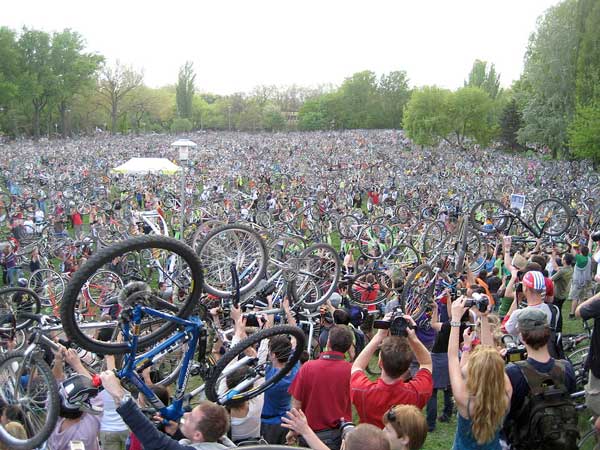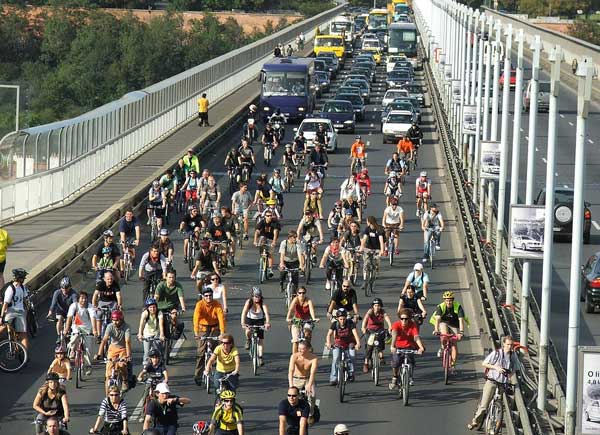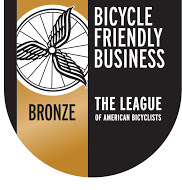 May is Bike Month. Bicyclists gather in a "Critical Mass" demonstration to show their concern for safe streets and protected bike lanes
May is Bike Month. Bicyclists gather in a "Critical Mass" demonstration to show their concern for safe streets and protected bike lanes
May is Bike Month and the impact of all those bicyclists, bike lanes, bike parking racks, bike share programs, bike accessories and bike trails have given this segment of society enormous clout.
Bike Month was created by the League of American Bicyclists. Cities all across the US have planned activities such as car-free days and get-togethers to celebrate this month. The number of active bicyclists in every town is increasing.
Just consider these statistics for example:
- There are a record number of bicyclists - last year 67 million people rode a bike in the last 12 months, according to Statista.com. In 2008 there were 47 million.
- Wheeled sports - mostly bicycles - account for $97 billion in outdoor spending every year, according to the Outdoor Industry Association.
- About $14 billion is spent yearly on bike and skateboard gear.
- Bike trips and other wheeled sports generate $83 billion in spending annually.
- Those expenditures on trips help to support 847,559 jobs.
- In 2015, direct sales of bicycles, parts, and accessories amounted to $6.2 billion, according to the National Bicycles Dealers Association.
- That same year, there were 3,790 specialty bicycle retail stores in the US.
- For states that heavily promote bicycling, the rewards are substantial. According to The League of American Bicyclists, in Wisconsin for example where 20% of bike manufacturing takes place and the residents participate in a large number of races, tours and trails, the industry generates about $556 million in revenue and supports 3,418 jobs.
- The League also reported the national bicycle industry adds an estimated $133 billion a year to the US economy. Provides more than 1.1 million jobs and generates $17.7 billion in tax revenue.
That's should certainly get the attention of city, state and national legislators.
Bike Month is a time to recognize all the benefits of bicycling
Then there's the environmental impact, which for a bicycle is non-existent. One of the best ways to cut carbon emissions from automobiles is to provide a way for people to get around without an automobile.
That's why cities have finally got the message and are investing heavily in bicycle infrastructure. New York City recently spent $100 million to make its streets safer for bicyclists. Seattle plans to spend $1 billion dollars over the next decade to improve their bicycling infrastructure. Almost every major city in the US now has a bike share program.
 Bicyclists in a critical mass demonstration
Bicyclists in a critical mass demonstration
Cars can be moved out of the picture. Look at Copenhagen where an estimated 50% of city residents commute to work by bicycle. American mayors and city planners are seeing the benefits of providing alternative modes of transportation as opposed to just building more roads, bridges, and parking garages.
In this time of the health care crisis, the impact that a major push for the use of bicycles could be enormous.
For example, a study in Medicine & Science in Sports and Exercise followed 1,500 subjects who were active daily and found that the group was 30% less likely to develop high blood pressure. There's also the weight loss involved which has been found to be a wonderful way to prevent heart disease, diabetes and cancer.
A study of Tour de France riders found that former professionals live on average to 81.5 years of age, compared to the general population longevity rate of 73.5 years.
If a major portion of a city's population could pedal to work every day, the impact on hospitals and health care cost would be tremendous.
Many city administrators and politicians would certainly agree bicycling is better for citizens.
But an investment is needed to make bicycling more appealing and safer to reward bicyclists.
That includes:
- More protected bike lanes in cities.
- Crackdown on motorists who don't provide a buffer or the right of way for bicyclists
- More bicycle parking in key areas such as train stations with the installation of more bike parking racks, bike rooms, and bike storage in parking garages.
- Safer corners as most major bicycle accidents, injuries and deaths take place at intersections.
A big milestone in changing the way people think about bicycle planning was recently achieved when the Federal Highway Administration acknowledged that the main purpose of a road was not to move just vehicles, but humans in general.
That means federal officials will also be on the lookout for how they can allocate funds to provide more protected bike lanes, bike parking racks, and bus lanes.
This coincides with the new mindset that cities are adopting the idea of "road diets" and looking instead for other ways to improve transportation in their cities.
Federal funding will play a key role in the growth of bicycling infrastructure in cities. Bicycle advocacy groups such as People for Bikes are hoping funds for bicycling infrastructure will be included in President Trump's proposed $1 trillion infrastructure program.
In a statement, People for Bikes said: "As Congress works to finish a funding bill for the current and next fiscal years, we will make the case that the federal government should continue to fund programs that support bicycling and integrate it into the US transportation system. These dollars go far beyond benefitting people who bike.
"Everyone wins…through reduced road congestion, better air quality, stronger business, and healthier communities. Continuing these modest cost-effective projects will ultimately save our nation money by reducing time stuck in traffic, the cost of providing parking, and the cost of health care related to physical inactivity."
All across America and even the world, bicyclists gather in "critical mass" events to show the power of their numbers to city officials. The idea for the event first started in San Francisco in 1992 and is now reportedly held in more than 300 cities around the world.
A critical mass is sometimes referred to as a "monthly protest by cyclists reclaiming the streets." But to most participants, these events are not necessarily demonstrations, but more like celebrations of people-powered transportation. The concept is copied after a practice in China when a "critical mass" of bicycle riders would gather at an intersection, and would then venture across as automobile riders recognized it was time to let this large group safely pass through.
As one can see, the mass of bicycle riders in the US is growing. So is the economic impact of this activity. More and more people are recognizing the many benefits that bicycling provides. Millennials say they prefer bicycling and try to avoid driving. Another big new trend is that bicycling by people ages 60 to 79 is booming, accounting for 22% of the country's increase in cycling. For seniors, bicycling is the new golf. But they do need a safe place to ride.
All these numbers show there is a huge demand for adequate bicycling infrastructure in America. From the need for more bike lanes, safe intersections, bike parking racks and bike share programs. Bicycling is a now a major economic and political force in America, and that's a great accomplishment to celebrate this Bike Month.
 Bicycle-Friendly Business Designation by the League of American Bicyclist
Bicycle-Friendly Business Designation by the League of American Bicyclist
Note: The Park and Facilities Catalog is a national supplier of commercial bike racks. The company has also been designated as a Bicycle-Friendly Business by the League of American Bicyclists.


